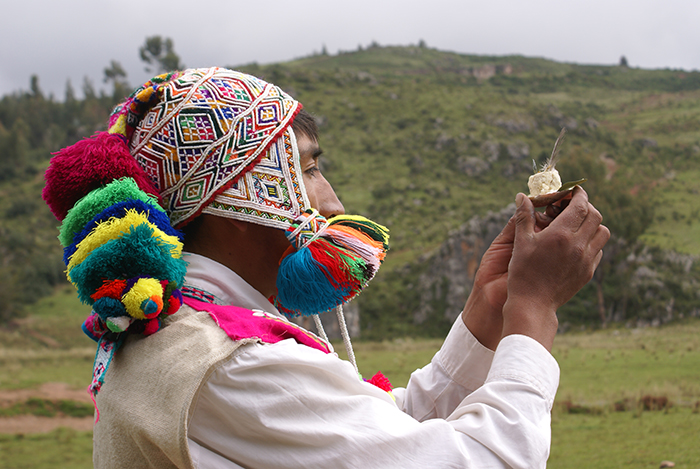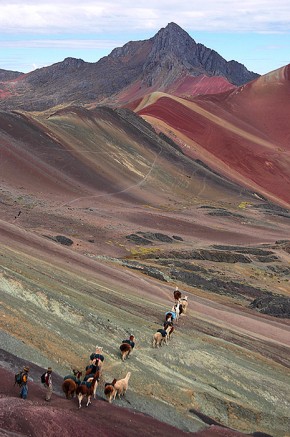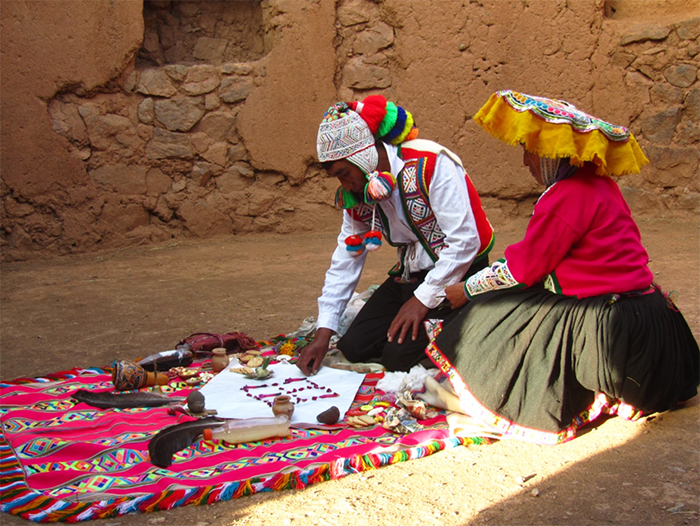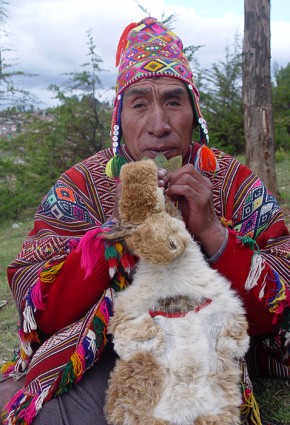An Offering to the Pachamama

The Peru program at the 2015 Folklife Festival takes its name from the Pachamama, translating to “Mother Earth” in the native Quechua and Aymara languages and signifying a wellspring of creativity, community, and connectivity. In this story, Rufino Turpo (son of the late Nazario Turpo, guardian and Pacco ritual master of the sacred Ausangate Mountain) shares the life-sustaining role of Pachamama: mother of all living beings, the core of existence, the symbol of fertility. Here he gives a firsthand account (translated from the original Spanish by Roger Valencia) of Andean rituals and roles in promoting the continuity of cosmic and earth lifecycles.
Yesterday at the San Pedro market, I bought items for an offering (despacho). My father never explained the process to me, but I know how it must be done. Since childhood, I participated in my father’s and my grandfather’s offerings.
On the first day of Chajrayapuy (August), our family gathers to make a “payment” or offering to the Pachamama. Like us, she needs to eat and drink. Whenever we drink chicha, beer, or wine, we need to share it with her.

I bought a full bundle for the offering, including a complete sullo, or dried llama fetus. Since this is the first time I am going to “pay” our Pachamama, I feel uneasy. She may not accept my offerings. The Mother gets angry when you want to pay without respect, without knowing why.
I have chosen my grandfather’s poncho to wear in this ceremony. He gave it to me, but out of respect for my father I did not use it while he was alive. Now that he has gone, he will see me and be happy that his majta (boy) is wearing the poncho passed down through our community.
I go down from the house slowly. When I walk, I remember the names of my town’s Apus (mountain spirits)—Ausangate, Cayangate, Colque Cruz—their yanas (mates), as well as the masis (companions). I also remember the names of the Apus I’ve met in other villages.
After greeting each of those present, I lay out the lliclla (woman’s shawl) made by my mother and on it an uncuña (small blanket) woven by my grandmother. I carefully lay down my father’s and grandfather’s illas (ritual figurines) and my own encaycho (spirit stone), which I received along with the first piece of land assigned to me in the community.
I organize the fields very carefully with carnation petals—white, pink, red. I separate each one into its two halves, because that is how the world is—Hanan and Urin—and in turn, each into male and female sections.

My offering is ready to receive coca. I ask everyone to choose their kintus (three coca leaves) from the chuspa (coca leaves pouch) for the offering, plus some for ourselves. We take them in our mouths, slowly rolling them inside one cheek (chajchar).
Raising the chicha container, I request to our mother:
“Pachamama, mother of all living beings, sustainer of life, please accept this offering. Pachamama, with your fertility, nurture our lives. Take this chicha that comes from you and the effort of your children,” and I spray the chicha forcefully, making muchay (like blowing kisses).
Then I raise the wine to the Apus, especially to Mr. Ausangate, saying:
“Great Father, origin of the waters, with your energy you make Pachamama fruitful. Accept this wine.”
Everyone has their kintu in hand. With devotion, I offer coca to the Apus, without forgetting anyone:
“Receive from my hands the coca that comes from the lower valleys, symbol of the return of water, born of your snow each morning with the sun’s warm light and returned each night converted into a river of stars Willcamayu (Milky Way).”
We make a bed of coca leaves. On it, we place a mullu (Spondylus shell) from the Mama Cocha, and on it the mullu wira, or llama tallow, representing Wiracocha (life’s energy). On the tallow, we add gold and silver, corn, qañihua (Chenopodium Pallidicaule goosefoot), wiracoya (incense), peanuts, lima beans, candy, and more. We offer all this for Pachamama to eat, and in return she provides for us and protects us.
Finally, we burn the offering. Smoke rises, taking our prayers. The coca in my mouth turns sweet, signaling that our payment has been accepted. The taste reminds me of the sweet leaves my grandfather gave me as a young boy. Because I think of him, I know he is present too.
Roger Valencia is working with the Perú: Pachamama team as a researcher for the Q’eswachaka Bridge case study.


